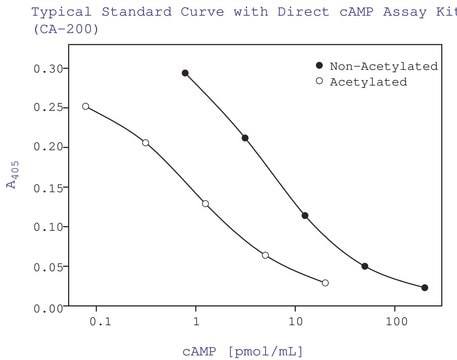CG200
cGMP Enzyme Immunoassay Kit, Direct
sufficient for 96 assays
Scegli un formato
CHF 790.00
Scegli un formato
About This Item
CHF 790.00
Prodotti consigliati
impiego
sufficient for 96 assays
Livello qualitativo
tecniche
ELISA: suitable
Condizioni di spedizione
wet ice
Temperatura di conservazione
−20°C
Informazioni sul gene
human ... PRKG1(5592) , PRKG2(5593)
Applicazioni
Solo come componenti del kit
- 0.1 M Hydrochloride Acid 1 x 30
- Acetic Anhydride 1 x 1
- cGMP-Alkaline Phosphatase Conjugate 1 x 5
- cGMP EIA Antibody Rabbit Anti-cGMP 1 x 5
- Cyclic GMP Standard 1 x 0.5
- Goat Anti-Rabbit IgG Coated 96 Well Microtiter Plate 1 ea
- Neutralizing Reagent 1 x 6
- p-Nitrophenyl Phosphate Substrate Solution 1 x 20
- Plate Sealer 1 ea
- Stop Solution 1 x 5
- Triethylamine 1 x 2
- Wash Buffer Concentrate 1 x 30
Avvertenze
Danger
Indicazioni di pericolo
Classi di pericolo
Acute Tox. 2 Inhalation - Acute Tox. 3 Dermal - Acute Tox. 4 Oral - Eye Dam. 1 - Flam. Liq. 3 - Met. Corr. 1 - Skin Corr. 1A - STOT SE 3
Organi bersaglio
Respiratory system
Rischi supp
Codice della classe di stoccaggio
3 - Flammable liquids
Punto d’infiammabilità (°F)
120.2 °F
Punto d’infiammabilità (°C)
49 °C
Scegli una delle versioni più recenti:
Certificati d'analisi (COA)
Non trovi la versione di tuo interesse?
Se hai bisogno di una versione specifica, puoi cercare il certificato tramite il numero di lotto.
Possiedi già questo prodotto?
I documenti relativi ai prodotti acquistati recentemente sono disponibili nell’Archivio dei documenti.
Active Filters
Il team dei nostri ricercatori vanta grande esperienza in tutte le aree della ricerca quali Life Science, scienza dei materiali, sintesi chimica, cromatografia, discipline analitiche, ecc..
Contatta l'Assistenza Tecnica.











